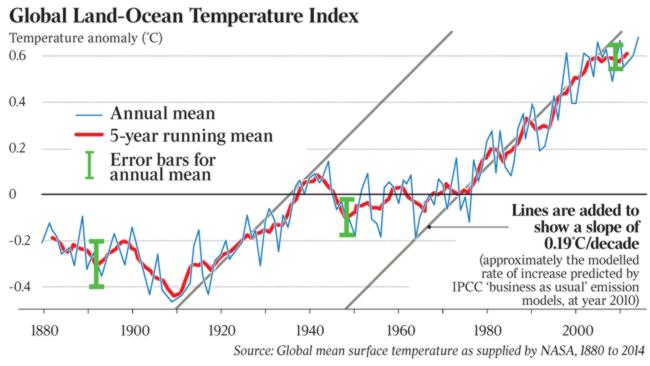Nope, they are not deniers. They are alarmists. Chicken littles spouting about how the sky is falling. ...
Is my post that was all at post 248 (Last part now moved here to reply to your post) also just an alarmist's creation / POV? or is it facts that are scary?
If not ALL facts, PLEASE tell which statements are false.
"First note CH4 is mainly removed from the air by reaction with the negative OH radical. I'm not a chemist but know it is a many step process but must be in net be something like this to balance out the reaction equation 2CH4 + 4OH + 3O2 ---> 2CO2 + 6H2O. The OH and the splitting of the 3 oxygen molecules is done high up in the atmosphere by harsh solar UV and the production rate of these oxidizers is thus limited by the harsh UV flux. Also note that four OH radical are needed to destroy two methane molecule. For last 800,000 years, the UV production rate was faster than the CH4 release rate so, as you can see in graph below, the CH4 concentration was held low. (Destroyed by the relatively more abundant OH radical.) BTW producing water, a much worse GHG than even CH4, high up in the atmosphere, I think, is the main source of it up there where rain droplets do not form, again "I think."
Now the release of CH4 is much more rapid and it is relatively more abundant than the OH radical. CH4 is stating to hold the OH radical concentration low. That means the average length of time a CH4 molecule "lives" - its half life is increasing. In 2003 the CH4 half life was 9.6 years, but in 2013 it had increased to 12.6 years. I. e. the half life is now increasing at about 0.3 years per year and the rate of increase is accelerating as the OH radical concentration falls. Fortunately most oil wells do now "flare off" the CH4 that comes up with the oil, and greater care is now being taken to reduce the CH4 escape for natural gas pipeline and gas well.
As you can see in the right half of the graph below, which has a much shorter time scale, the CH4 concentration in the air is still increasing, but at a slower rate, in large part due to these more careful controls of the oil and gas industries as they try to reduce CH4 release. Counter balancing this, is that a "finger" of the Gulf Stream is now entering the Arctic Ocean and flowing along the Siberian continental shelf. Probably why CH4 from decomposing methane hydrates is bubble up to the surface now even in kilometer diameter zones. I'll try to find again the video showing them, and insert link to it here but found this general discussion first:
Natalia Shakhova, has lead the Russian Arctic Ocean CH4 research for about two decades - a leading Global Warming expert and Member of the Russian Academy of Sciences, Far Eastern Branch, Pacific Oceanological Institute, Vladivostok. This video is an invited presentation / interview she gave at University of Alaska, Fairbanks, International Arctic Research Centre, USA where I believe she is now or occasionally is a professor also. Worth less than nine minutes your time to hear it in full if interested to better understand the serious nature of the CH4 threat.
This inter-glacial period is different from all prior ones in the last 800,000 years:
After air became oxidizing, the Sun's rate of production of the OH radical held the CH4 concentration low, but now CH4 is holding the OH radial concentration low.
Even at the current half life 1Kg of CH4 does more global warming than 100Kg of CO2 in the first decade after their release. The amount of releasable CH4 holds more carbon than exists in all the coal on earth. I.e. for practical purposes*, there is no limit on how high the CH4 concentration can climb. That is why this time is not only "different" but very scary. May make humans and all animal that perspire to keep cool except very tiny ones become extinct. (The tiny ones, like small mice, have much higher surface to body mass ratios and also can/ and do/ spend most of the heat of the day in their burros at the average temperature and lower at night.)
Thus the Bible may be correct in its forecast that:
"The meek {the mice} shall inherit the Earth"
* Mankind will be extinct before that limit is reached.
People, like Eskimos who know how to live in Arctic regions will not be "done in" by the heat, but by ocean acidification which will remove much of their food supply, including the seals they hunt at the top of a food chain, which is collapsing from the bottom up. It is not a pretty picture I paint and it may be wrong, but that is no reason not to switch to sugar cane alcohol for transportation fuel ASAP. There is enough abandoned pasture to grow cane for all the world's cars needing liquid fuel a decade from now and the new distillation plants needed can be built more rapidly than that. There are many advantages of such a switch, in addition to less cost per mile driven and a renewable fuel that is slightly "CO2 negative" displacing gasoline, including creation of many low skill required jobs for people not now part of the "cash economy" who would buy products from the "first world" if they could - that creates more high tech jobs too.
If you are willing to hear a very depressing, but fact filled and well referenced talk watch this:
End of post 248, part here now for your convenience (so not a "double posting" quote)




